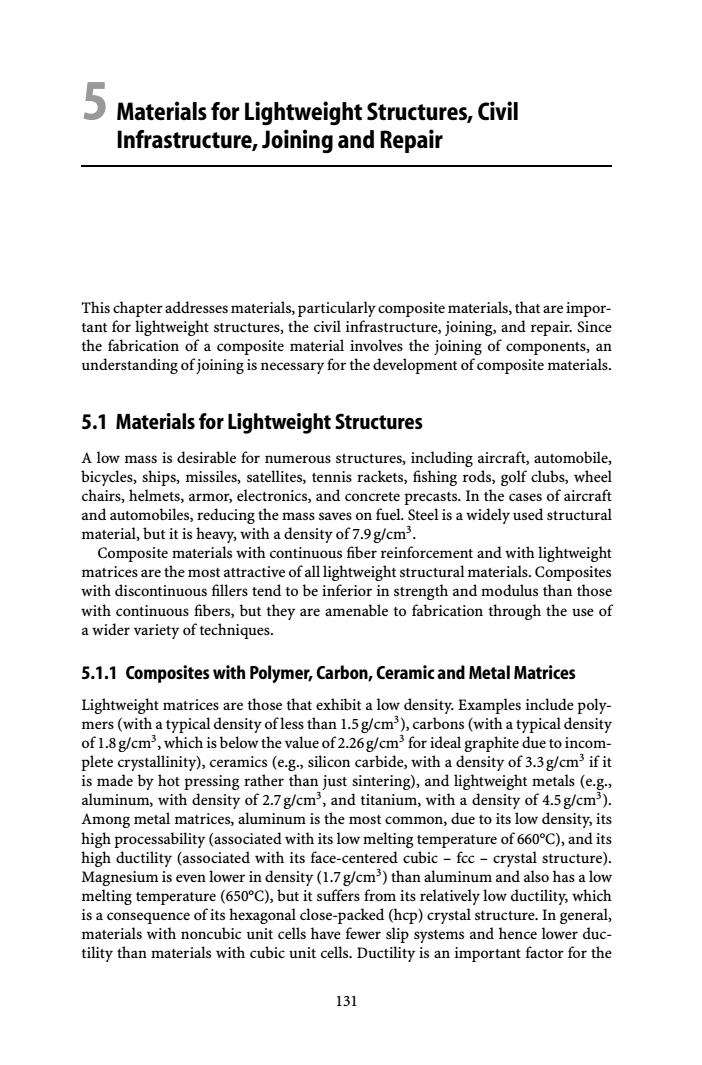正在加载图片...

5 Materials for Lightweight Structures,Civil Infrastructure,Joining and Repair This chapter addresses materials,particularly composite materials,that are impor- tant for lightweight structures,the civil infrastructure,joining,and repair.Since the fabrication of a composite material involves the joining of components,an understanding of joining is necessary for the development of composite materials. 5.1 Materials for Lightweight Structures A low mass is desirable for numerous structures,including aircraft,automobile, bicycles,ships,missiles,satellites,tennis rackets,fishing rods,golf clubs,wheel chairs,helmets,armor,electronics,and concrete precasts.In the cases of aircraft and automobiles,reducing the mass saves on fuel.Steel is a widely used structural material,but it is heavy,with a density of 7.9g/cm3. Composite materials with continuous fiber reinforcement and with lightweight matrices are the most attractive of all lightweight structural materials.Composites with discontinuous fillers tend to be inferior in strength and modulus than those with continuous fibers,but they are amenable to fabrication through the use of a wider variety of techniques. 5.1.1 Composites with Polymer,Carbon,Ceramic and Metal Matrices Lightweight matrices are those that exhibit a low density.Examples include poly- mers(with a typical density of less than 1.5 g/cm),carbons(with a typical density of 1.8 g/cm3,which is below the value of 2.26g/cm3 for ideal graphite due to incom- plete crystallinity),ceramics(e.g.,silicon carbide,with a density of 3.3g/cm3 if it is made by hot pressing rather than just sintering),and lightweight metals(e.g., aluminum,with density of 2.7 g/cm',and titanium,with a density of 4.5g/cm). Among metal matrices,aluminum is the most common,due to its low density,its high processability(associated with its low melting temperature of 660C),and its high ductility (associated with its face-centered cubic-fcc-crystal structure). Magnesium is even lower in density(1.7 g/cm3)than aluminum and also has a low melting temperature(650C),but it suffers from its relatively low ductility,which is a consequence of its hexagonal close-packed(hcp)crystal structure.In general, materials with noncubic unit cells have fewer slip systems and hence lower duc- tility than materials with cubic unit cells.Ductility is an important factor for the 1315 Materials for Lightweight Structures, Civil Infrastructure, Joining and Repair This chapter addresses materials, particularly composite materials, that are important for lightweight structures, the civil infrastructure, joining, and repair. Since the fabrication of a composite material involves the joining of components, an understanding of joining is necessary for the development of composite materials. 5.1 Materials for Lightweight Structures A low mass is desirable for numerous structures, including aircraft, automobile, bicycles, ships, missiles, satellites, tennis rackets, fishing rods, golf clubs, wheel chairs, helmets, armor, electronics, and concrete precasts. In the cases of aircraft and automobiles, reducing the mass saves on fuel. Steel is a widely used structural material, but it is heavy, with a density of 7.9g/cm3. Composite materials with continuous fiber reinforcement and with lightweight matrices are the most attractive of all lightweight structural materials. Composites with discontinuous fillers tend to be inferior in strength and modulus than those with continuous fibers, but they are amenable to fabrication through the use of a wider variety of techniques. 5.1.1 Composites with Polymer, Carbon, Ceramic and Metal Matrices Lightweight matrices are those that exhibit a low density. Examples include polymers (with a typical density of less than 1.5g/cm3), carbons (with a typical density of 1.8g/cm3, which is below the value of 2.26g/cm3 for ideal graphite due to incomplete crystallinity), ceramics (e.g., silicon carbide, with a density of 3.3g/cm3 if it is made by hot pressing rather than just sintering), and lightweight metals (e.g., aluminum, with density of 2.7g/cm3, and titanium, with a density of 4.5g/cm3). Among metal matrices, aluminum is the most common, due to its low density, its high processability (associated with its low melting temperature of 660°C), and its high ductility (associated with its face-centered cubic – fcc – crystal structure). Magnesium is even lower in density (1.7g/cm3) than aluminum and also has a low melting temperature (650°C), but it suffers from its relatively low ductility, which is a consequence of its hexagonal close-packed (hcp) crystal structure. In general, materials with noncubic unit cells have fewer slip systems and hence lower ductility than materials with cubic unit cells. Ductility is an important factor for the 131